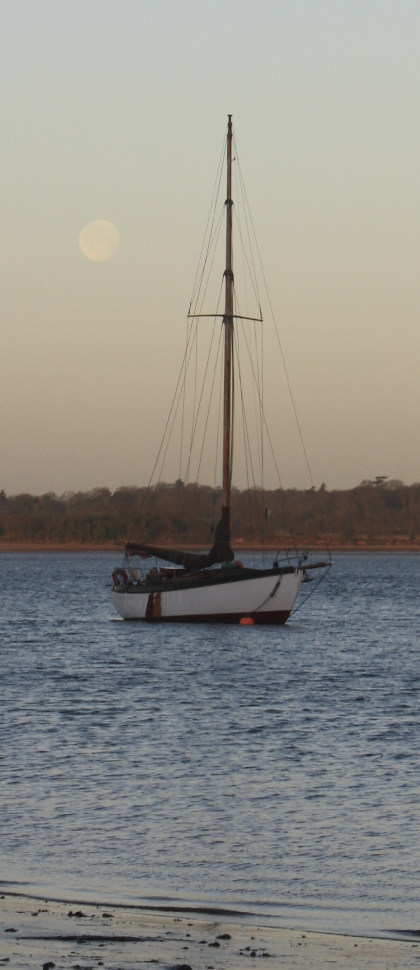| | Tramontana is a 36 foot wooden sailing boat. She was designed by Harrison Butler for an Auckland yachtsman who intended to build her himself for cruising the South Sea Islands. As the 'Cayuca' design, she featured in the December 1933 edition of Yachting Monthly. In 1934, named Morena, she was built by Anderson, Ridgen & Perkins in Whitstable, Kent, for Commander ARJ Southby (later knighted). He owned her until 1952. She then had two further owners in rapid succession, one of whom renamed her Tramontana. In 1956, Norman Alexander began 35 years of ownership, before selling her to Michael & Joan Wilson. David Batstone became Tramontana's sixth custodian in 2002 before I bought her, Christmas 2012.
With a registered tonnage of 14.4 tons and a draught of 7' 3", Tramontana is the largest of the two hundred boats built to Harrison Butler's designs. She's a distinctive sight with a red hull, red sails and her name in clear gold letters on the bow. She can sleep five in two double cabins and a quarter-berth. Aboard is a Taylor cooker, Waeco fridge, and what I've been told is the Rolls Royce of heads; a Blake's Victory. In 2017 a new engine, a Beta Marine 60, was installed. The anchor winch is a dangerous beast that tried to take my finger off in 2013; dropping the hook is easy, weighing anchor requires time and care.
Tramontana is a well balanced boat that can often be encouraged to sail herself. I've have a 'Sea Feather' self steering (under sail) system installed, but not yet tried it out properly. Tramontana likes a force four and I've been solo in her in a few force six 'situations', which were managable. My preference is to sail when the weather is fair, and stay in port when it's not. I often have Zeta (my Springer Spaniel), Helen (my other half) and Frida (my three and a half old daughter) with me.
| |
| | If you are joining Tramontana as crew I thought it would be useful to know in advance about the facilities on board and what I'm expecting you to bring. Everyone gets their own locker space. Squashable bags are better than hard suitcases. If you are in the forepeak double cabin or the aft quarter berth single cabin you have your own sleeping and resting spaces all of the time. If you are berthed on one of the two single saloon bunks, you'll have to tidy away for meal times and are more likely to be disturbed as others move about the boat. There is no mobile phone reception or internet at sea. You may get a mobile phone signal within half a mile of land. Most marinas provide Wi-Fi.
Facilities on Board
• GPS, compass, charts, pilot books, tide tables & tidal atlas, Navtech (weather info)
• Flares (in date), fire extinguishers, first aid kit
• Life jackets, life lines, safety harnesses
• VHF radio (Supervised by Martin or Helen, both of whom are licensed)
• Binoculars
• 240 volt mains electricity sockets for when in a marina with hook up
• Small fridge (for use when in port with mains electricity)
• Mains kettle, toaster & coffee grinder for use in port (stowed when at sea)
• 12 volt DC electricity supply, like in a car. (iPhone charger on board)
• DVD player (works at sea; 12 volt system)
• Good LED lighting for use at sea, separate system when in port
• Oil lamps (as backup)
• Head torches (x2)
• Two burner paraffin stove with oven (can be used at sea)
• Long life food, ample crockery & cutlery, pots & pans, hob kettle
• Wood burning stove, for use when at anchor or motoring in a calm sea
• Toilet (Heads) - only for use at sea - use Marina toilets when in port
• Cold water system, for washing hands and dishes, not for drinking
(No shower on board - Use Marina showers when in port)
• A four person (max) rowing boat with outboard motor
• A few games, cards, nautical books and DVDs
What is provided
• Bedding (Duvet, sheet, pillow): All clean !
What you need to bring
• Waterproof clothing, although I have some on board
• Sun hat, long sleeved shirt (Sun on deck can be very intense)
• Warm clothing (Cold at night, especially when sitting in cockpit)
• Beach or cove kit; swimming trunks, beach towel, flip flops
• Toiletries, including a towel - small mains hair dryer aboard
• Eye mask if early morning light will disturb you
• Ear plugs if wind through rigging & assorted creaking noises will disturb you
• Camera, Book, Magazine
• Charger(s) for any portable electrical device: e.g. Kindle, iPad, Phone, Camera...
The Iron Main - Sail
The ship's diesel tank holds 90 litres, and a further 60 litres is carried in six 10 litre cans. This is enough for around 30 hours of continuous motoring. This would allow us to cover a distance of around 120 nautical miles under engine. The point of a sailing boat is, of course, to sail and the auxiliary engine is typically used to get in and out of port. We also carry two 5 litre cans of unleaded petrol for use in the outboard engine. There is no bottled gas aboard, but around 5 litres of paraffin and a litre of methylated spirits for the stove.

Tramontana moored off Wrabness Point, River Stour, Essex, August 2013
| |


